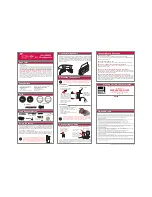
2
CONNECTIONS
T
RUE
B
I
-W
IRE
C
ONNECTIONS
As part of the upgrades an improvements that elevate the
performance of the Treo they are outfitted with a four termi-
nal barrier strip. This may require different cable termina-
tions and connection methods. Spades or ring terminals are
recommended.
Please follow the appropriate instructions below when
connecting your Treo Loudspeakers.
With all the connection methods, the input
screws should be snug, but not over tightened.
True bi-wiring is recommended for all systems using a
single stereo amplifier or two mono amplifiers. Four identi-
cal runs of equal length cable are required. (Two per
speaker).
1. Crimp and solder spade lugs to the speaker ends of the
cables being used to connect the Treo.
2. Choose one of the cables as high-frequency cable. Con-
nect this cable to the two terminals on the right carefully
observing proper polarity.
3. Connect the remaining cable to the two left terminals
carefully observing proper polarity.
4. Connect both cables in proper polarity to the same set of
outputs on your amplifier. If possible, use only one
spade lug to connect both cables to each terminal on the
amplifier as shown in the amplifier connection.
I
NTERNAL
B
I
-W
IRE
C
ONNECTIONS
If your domestic situation dictates the use of a single ca-
ble per speaker, you should use a multiple-conductor single-
sheath cable to internally bi-wire the speakers. Some of
these cables use different types of wire for the upper and
lower ranges of the speaker and may affect the blend be-
tween the woofer and midrange drivers. They should only
be used after you audition them in your system and verify
that they do not affect the woofer to midrange blending and
that you like their sonic characteristics.
1. Crimp and solder spade lugs to the speaker ends of the
cable from the amplifier.
2. Connect one positive and one negative wire to the high-
frequency terminals on the right carefully observing
proper polarity.
3. Connect the remaining positive and negative wires to
the low-frequency terminals on the left carefully observ-
ing proper polarity.
4. Connect the wires in proper polarity to the same set of
outputs on your amplifier. If possible, use only one
spade lug to connect both positive wires and one spade
lug to connect both negative wires to the amplifier as
shown in the diagram.
With all the connection methods, bare wires
should never come into contact with the alumi-
num plate while the amplifier in on. Amplifier
damage could result.
Carefully verify cable polarity at both speaker
and amplifier before using the bi-wire or verti-
cal bi-amp connection methods.
True
Bi - Wire
Internal
Bi - Wire
Amplifier
Terminal
Amplifier
Terminal






























